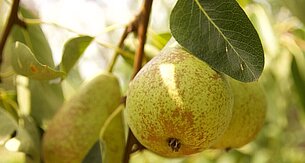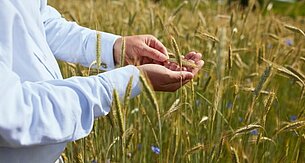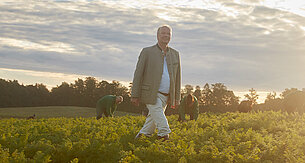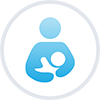
Frequently asked questions on formula milks
Explore our most frequently asked questions and answers to help you discover more about HiPP's range of formula milks and give you the useful information you need.
If you have a question that you can't find the answer to on this page, send us a message using our contact form.
How do I make a bottle for my baby using HiPP formula milk powder?
All milk formula feeds should be made up following the instructions on the packaging. These have been developed in line with NHS guidelines to make sure milk feeds are made as safely as possible.
First things first – start by washing your hands and making sure that all equipment is thoroughly washed and sterilised following the manufacturer’s instructions. Equipment should be sterilised until your baby is at least 12 months old.
Boil 1 litre of freshly-run tap water and leave to cool for no longer than 30 minutes. It needs to stay at a high temperature of around 70˚C. Do not use artificially softened or repeatedly boiled water.
Measure the required amount of water into a sterilised bottle, following the feeding guide on the pack.
Using the scoop provided, add the right number of scoops of powder – one level scoop of powder for each fluid ounce of water (approx. 30 ml). Level off the powder with the back of a clean dry knife, but don't press the powder down into the scoop.
Place the sterilised teat and cap on the bottle and shake well until all the powder has dissolved (this should take approx. 15 seconds).
Cool the milk to drinking temperature (approx. 37°C) by holding the bottle under cold running water. ALWAYS test the temperature of the milk before feeding by dripping a bit onto the inside of your wrist; the milk should feel warm, not hot.
You can start introducing a cup or beaker rather than a bottle after the age of around 6 months.
Note: Our Anti-Reflux Specialist Formula has different mixing instructions and it is, therefore, important you follow the guidance on the packaging, otherwise this product may not mix to the consistency required.
When should my baby stop drinking formula?
Formula-fed babies should continue on their chosen formula milk (infant or follow on from 6 months) until they are at least 12 months old.
From 1 year on, they can start to drink whole cow’s milk or move on to growing up milk.
We know everyone has different experiences and wants to do the very best for their little ones. Some families choose to transition their little ones to Growing up milk to complement their diets as they grow, but this is an individual choice for you to make as a family. Growing up milk is fortified with important nutrients such as vitamins C and D.
How should I store formula milk for night feeds?
We follow the guidelines set out by the Department of Health, which advise that each feed should be made up fresh and then immediately fed to the baby within 2 hours of preparation. Storing prepared formula feeds in the fridge may result in bacteria growth, and we therefore cannot recommend this.
Which formula milk is best for my baby?
First infant milk 1 is suitable for use from birth onwards. It is the only safe alternative to breastmilk for babies under 6 months.
Follow on milk 2 is for use from 6 months, as part of a mixed weaning diet.
Growing up milk 3 is for use from 12+ months onwards, as part of a mixed diet.
What's the difference between your formula milk products?
HiPP’s first infant milk is a nutritionally complete breastmilk substitute, suitable from birth. It contains all the nutrients your baby needs if they are not being breastfed. The only food recognised by the World Health Organisation as a suitable and safe alternative to breastmilk is a scientifically developed infant formula.
HiPP follow on milk is suitable from the age of 6+ months. It is formulated to be used alongside a varied weaning diet. It has been developed to meet the nutritional needs of older infants and contains higher levels of some nutrients such as Vitamin D and iron.
Follow-on milk is a choice for parents to make based on their baby’s needs and preferences. Generally, if a bottle-fed baby is happy on their first infant milk there’s usually no reason to change them onto a follow-on milk just because they’ve reached the age of six months. It’s up to you.
HiPP growing up milks are designed to complement your toddlers’ diet to help support their growing needs. It offers an alternative to whole cows’ milk for toddlers and children over 12+ months and is fortified with important nutrients such as vitamins C and D and calcium. Growing-up milk is optional; some families choose it and some don’t.
Can you reheat formula milk?
It is not recommended to reheat formula milk. Each feed should be made fresh and used immediately. Any formula milk left over after a feed should be discarded.
How long does formula milk last for once a bottle has been made up?
Once a bottle of formula powder has been made up, it can be kept at room temperature for up to 2 hours. Any unused feed in that bottle after this time should be discarded.
Can I freeze formula milk?
No. We have not tested our formula milks at these temperatures and cannot, therefore, guarantee their safety once frozen. Some of the heat-sensitive nutrients, such as vitamins and fatty compounds, may suffer from these extreme temperature variations and in addition, the powder texture and efficacy of the finished milk bottle might change.
How much formula milk should I give my baby?
The amount of milk your baby will need will vary depending on their age and weight. Newborns generally only need a small amount but this will grow as they get older and bigger.
Most babies will fall into their own feeding pattern and routine and you should feed your baby when they show signs of being hungry. Don’t ignore your baby’s hunger cues to stick to a strict regime.
When your baby is first born, they will usually only take small amounts of milk. Once they are about a week old, they will need between 150 ml and 200 ml per kilogram of their body weight over a 24-hour period, until they are around 6 months old. This means a baby that weighs 5 kg or 11 lb will need between 750 ml and 1 litre of formula milk per day. How much formula they will need will depend on how heavy they are and, of course, all babies are different and some will have bigger appetites than others.
You may find there are times when your baby wants to bottle feed more often than usual. This might be because they are teething or feeling unwell, or they may be experiencing a growth spurt.
If you have any concerns about how much to feed your baby, chat with your healthcare professional who will be able to advise you further.
How should I transition my baby from another formula milk to HiPP?
We would always advise that you speak to your healthcare professional to discuss the best formula milk for your baby. Some babies can change from one milk to another quite quickly, while other babies move over gradually taking a number of days to transition fully onto the new milk. This is something that can be discussed with your healthcare professional.
Can I use bottled water for baby formula?
There may be certain times when you need to use bottled water to make up baby’s feeds, such as if there is a mains water supply issue or you are travelling. Generally, however, it is best to use tap water.
If you are using boiled and cooled bottled water, check the label to make sure that there is no more than 200 mg per litre of sodium (‘Na’), and no more than 250mg per litre of sulphate (‘SO’ or ‘SO4’).
How can I make formula milk when out and about?
If you’re making up a feed while you’re away from home, you’ll need a flask of just-boiled hot water, a measured amount of formula in a clean, dry container, and a sterilised bottle that’s ready to use. Simply mix the powder and water in the bottle and give it a good shake to mix. You want the water to be around 70˚C, so you’ll need to use a vacuum flask that retains heat well. Measuring out the powder in advance makes it simple to ensure you have the right amount.
Only make up the feed when your baby needs it, and remember to cool the bottle (with the lid on!) before you feed it to your baby. If there isn’t cool running water available while you’re out, you might also need to take a flask of cold water with you.
You might find it simpler to take a ready-to-feed bottle of liquid formula with you, which doesn’t need to be made up.
How long can I keep formula milk in the fridge?
HiPP follows the Department of Health and NHS guidelines, and we do not recommend that formula milks are prepared in advance. Each feed should be made fresh and so we do not recommend that milk feeds are made up in advance and stored in the fridge.
However, if for some reason you need to transport a made-up feed, prepare it as usual and then cool it for at least 1 hour in the back of the fridge, where it is coldest. Just before you leave, take the bottle out of the fridge and put it in a cool bag with an ice pack. Use within 4 hours.
Our ready-to-feed milk can be stored in the fridge for a short time. Once the HiPP bottle is opened and the milk is decanted into the baby’s feeding bottle, any remaining milk in the HiPP bottle can be refrigerated immediately after opening – for first infant milk for up to 24 hours, or 48 hours for follow on and growing up milk. Leftover milk in your baby’s bottle should be discarded.
What is follow on milk?
HiPP’s follow on milk is designed to provide the nutrients your baby needs alongside a varied weaning diet, when they are not being breastfed. It is suitable from the age of 6+ months and has been developed to meet the nutritional needs of older infants and contains higher levels of some nutrients, such as Vitamin D and iron.
What is growing up milk?
Growing up milks are designed to complement your toddlers’ diet from the age of 12+ months when they are not breastfed; some families prefer to use whole cows’ milk.
HiPP GUM 3 is fortified with important nutrients, such as vitamins C and D and calcium.
What is anti-reflux formula milk?
HiPP Anti Reflux milk is a thickened, nutritionally complete milk formula that is suitable for the dietary management of reflux and regurgitation from birth, under medical supervision. It can be used as the sole source of nutrition for babies under 6 months, or as part of a varied weaning diet when introduced at around six months.
Please speak to your healthcare professional for advice before use.
What is comfort formula milk?
HiPP Comfort milk is a nutritionally complete milk formula that’s suitable for the dietary management of colic and constipation from birth.
Under medical supervision, it can be used as the sole source of nutrition for a baby, or as part of a varied weaning diet when introduced at around six months.
Please speak to your healthcare professional for advice before use.
How many bottles does 800g of formula milk make?
The number of bottles made from an 800gm box of formula milk will depend on the size of the bottle that you are making as well as the formula you are using.
On the back of the boxes, the guidance will confirm the weight of powder per scoop and if you divide that number into 800gm, this will give you the approximate number of scoops per box.
As an example: First Infant Milk – 800gm divided by 4.3gm per scoop = approximately 186 scoops. If you are using 5 scoops per feed (150ml of water) then divide 186 by 5 = approximately 37 bottles of 150ml per box.
Can I prepare bottles of formula milk in advance?
HiPP follow the Department of Health and NHS guidelines, and we do not recommend that formula milks are prepared in advance.
However, if for some reason you need to transport a made-up feed, prepare it as usual and then cool it for at least 1 hour in the back of the fridge, where it is coldest. Just before you leave, take the bottle out of the fridge and put it in a cool bag with an ice pack. Use within 4 hours.
You might find it simpler to use ready-to-feed liquid formula.
How many poos should a formula-fed baby do?
From around 4 weeks of age, babies pass stools on average three times a day, but this can range from once every 2-3 days to six times a day. When you start introducing some ‘solid’ meals, usually at around 6 months old, the digestive system adapts and your baby is likely to poo less frequently and the consistency will become thicker and usually darker and smellier too.
At 1 year, the average is two poos per day. It is worth remembering that stool size, colour, texture and frequency reflect what has recently been consumed, so the colour of your baby’s stools will vary depending on what food you are feeding them. If you notice a definite change, such as poo becoming very smelly, very watery or harder (particularly if there’s blood in them), you should talk to your doctor or health visitor.
How can I transition my baby to another HiPP formula milk?
Some babies can change from one milk to another quicker than others, while other babies move over gradually, taking a number of days to transition fully onto the new milk. This is something that you should also discuss with your healthcare professional.
Can I use powder and ready-to-feed together?
Yes. You can feed your baby a combination of both powdered and ready-to-feed formula milks. Many parents tend to use the ready-to-feed milks for convenience when out and about or for night feeds, and then the powdered formula the rest of the time.
Can I use formula milk powder in weaning recipes?
Both made-up formula milk and whole cows' milk can be used in cooking or mixed with food from around 6 months of age.
How would I know if my baby has lactose intolerance or a cow's milk allergy?
Lactose intolerance and cows’ milk allergy are not the same and therefore need to be treated differently. For this reason, it is important that you consult with your GP or healthcare professional and do not self-diagnose.
Lactose intolerance is when the body reacts to milk as it cannot digest the lactose (a natural sugar found in milk) and can also sometimes happen for a little while after experiencing a tummy bug. Symptoms of lactose intolerance could be diarrhoea, vomiting, stomach rumbling and pains and wind.
Symptoms of a cow’s milk allergy can sometimes be sickness or diarrhoea and signs of a red itchy rash around the mouth, facial swelling, red lumps on the body, or a runny nose. Symptoms usually show themselves immediately after a milk feed. There are, however, times when there are delayed reactions such as eczema or poor growth, which is why it is very important to seek advice from your GP or healthcare professional to obtain a correct diagnosis.





